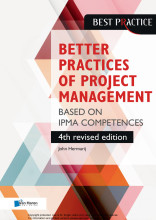Summary: Cissp: Certified Information Systems Security Professional Study Guide | 9781118332108 | James M Stewart, et al
- This + 400k other summaries
- A unique study and practice tool
- Never study anything twice again
- Get the grades you hope for
- 100% sure, 100% understanding
Read the summary and the most important questions on CISSP: Certified Information Systems Security Professional Study Guide | 9781118332108 | James M. Stewart; Mike Chapple; Darril Gibson
-
1 Toets
This is a preview. There are 29 more flashcards available for chapter 1
Show more cards here -
How many possible keys exist in a 4-bit key space?
16
To detemine the number of keys in a key space, raise 2 to the power of the number of bits in
the key space. In this example, 2^4 = 16. -
What type of cipher relies on changing the location of characters within a message to archieveconfidentiality?
Transposition cipher
Transposition ciphers use a variety of techniques to reorder the characters within a message -
What is the minimum number of cryptographic keys required for secure two-way communicationsin a symmetric key cryptography?
1
Symmetric key cryptography uses a shared secret key. All communicating parties utilize thesame key for communication in any direction. -
How many keys are required to fully implement a symmetric algorithm with 10 participants?
45
The number of keys required for a symmetric algorithm is dictated by the formula (n*(n-1))/2,
which in this case, where n=10, is 45 -
If Richard wants to send an encrypted message to Sue using a public key cryptosystem whichkey does he use to encrypt the message?
Sue's public key
Richard must encrypt the message using Sue's public key so that Sue can decrypt it using her
pivate key. If he encrypted the message with his own public key, the recipient would need to
know Richard's private key to decrypt the message. If he encrypted it with his own private key,
any user could decrypt the message using Richard's freey available public key. Richard could
not encrypt the message using Sue's private key because he does not have access to it. If he
did, any user could decrypt it using Sue's freely available public key. -
John wants to produce a message digest of a 2,048-byte message he plans to send to Mary. Ifhe uses the SHA-1 hashing algorithm, what size will the message digest for this particularmessage be?
160 bit
The SHA-1 hashing algorithm always produces a 160-bit message digest, regardless of the
size of the input message. In fact, this fixed-length output is a requirement of any securehashing algorithm. -
Which of the following technologies is considered flawed and should no longer be used?
WEP
The WEP algorithm has documented flaws that make it trivial to break. It should never be used
to protect wireless networks. -
What encryption technique does WPA use to protect wireless comminications?
WiFi Protected Access (WPA) uses the Temporal Key Integrity Protocol (TKIP) to protect
wireless communications. WPA2 uses AES encryption. -
Richard received an encrypted message sent to him from Sue. Which key should he use todecrypt the message?
Sue would have encrypted the message using Richard's public key. Therefor, Richard nedds to
use the complementary key in the key pair, his private key, to decrypt the message. -
Richard wants to digitally sign a message he's sending to Sue so that Sue can be sure themessage came from him without modification while in transit. Which key should he use toencrypt the message digest?
Richard should encrypt the message digest with his own private key. When Sue receives the
message, she will decrypt the digest with Richard's public key and then compute the digest
herself. If the two digests match, she can be assured that the message truly originated from
Richard.
- Higher grades + faster learning
- Never study anything twice
- 100% sure, 100% understanding






























